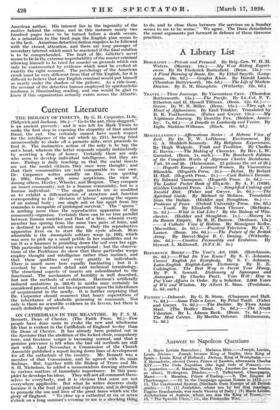Current Literature
THE BIOLOGY OF INSECTS. By G. H. Carpenter, D.Sc. (Sidgwick and Jackson. 16s.)--". Go to the ant, thou sluggard, is an ancient proverb ; and it was left for Mark Twain to make the first step in exposing the stupidity of that ancient fraud, the ant. One certainly cannot have - much respect for the intelligence of the ant which (p. 251), having tried unsuccessfully to shake off a parasite mite, next proceeds to feed it. The instinctive action of the mite is ,to" tap the ant's head, whereon the latter responds equally instinctively. by secreting a drop of honey. Certainly there are ants who seem to develop individual intelligence, but they
rare. Biology is daily teaching_ Us_ that the social- insects are not the model citizens. they , once were thought ; and- that their communities are 'hot - comparable to our own. Dr. Carpenter writes souhdly on this, even quoting (p. 260), though with some scepticism, the view of, among others, Huxley, Wheeler, and Bergson. They compare an insect community, not to a human community, but to a human individual. "The single insects are So modified as to exhibit a differentiation of structure and function corresponding to the 'division of labour,' among -the organs of an animal body ; one single -ant "or bee apart from her comrades is incapable of prolonged Survival." The " queen " is nothing more than the reproductive apparatus of this community-organism. Certainly there can be no true parallel between human societies and that of a hive, wherein every member has sprung from the same two pairs of- loins,-, and is destined to perish without _issue. Only the reproductive apparatus lives on to start the life cycle afresh. More admirable is the Ammophila solitary wasp (p. 106), which was seen to pick up a small pebble in her mandibles and to use It as a hammer in pounding down the soil over her eggs. This particular individual was exceptional ; _ but the observa- tion's of the Peckhams do show that these particular Wasps employ thought and intelligence rather than instinct, and that these qualities vary very greatly in individuals. There is much more here equally fascinating ; but it is overlaid by too much detail and technical terminology. The structural aspects of insects are subordinated to the functional. The mechanism of heredity is well described, but not the methods of evolution. Harrison's artificially induced mutations (p. 365-6) in moths may certainly be considered proved, but not his experiment upon the inheritance of acquirement in the sawfiy. It is further surprising that Dr. Carpenter should resurrect that hoary* superstition of the inheritance of alcoholic poisoning in mammals. Not only is there no scientific evidence in its favour, but there is much definitely against it.










































 Previous page
Previous page